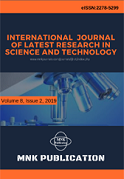DOI:10.29111/ijlrst ISRA Impact Factor:3.35, Peer-reviewed, Open-access Journal
Open Access
International Journal of Latest Research in Science and Technology Vol.9 Issue 5, pp 12-17,Year 2020
Correspondence should be addressed to :
Received : 23 October 2020; Accepted : 08 November 2020 ; Published : 18 November 2020

| Download | 128 |
|---|---|
| View | 185 |
| Article No. | 11006 |
This study aimed at using fiber of polyethylene terephthalate (PET) embedded in the concrete. The methodology used to obtain the results was based on the experimental IPT assay method. The concrete dosage is 1:0.8:4.2:0.5; 1:0.5:3.5:0.5; 1:3.1:2.9:0.5; with 0%, 2%, 3% and 4% polymer respectively with the nominal strength of 25 MPa and SLUMP 60 ± 20 mm, mixed in a concrete mixer with a capacity of 120 liters in the time 15 minutes each trait. Thus, were made following the test body 192 of cylindrical form 10 cm diameter by 20 cm, according to NBR 5738/2008, the concretes in ages of 7, 14, 21 and 28 days after twenty-four hours were immersed in tanks with water, remaining until the break according to the above requirement. In the analysis of the results revealed that all traces reached the desired strength, with the specimens 2%, 3% and 4% higher mechanical strength 25.84; 26.8; 30 MPa, among the samples analyzed, attributed to this increase possibly the geometric feature of the fiber 0.03mm x 0.01mm, allowing certain PET fiber grip with the concrete matrix.
Copyright © 2020 Neilson Oliveira da Silva et al. This is an open access article distributed under the Creative Commons Attribution 4.0 International (CC BY 4.0) license which permits unrestricted use, distribution, and reproduction in any medium, provided the original work is properly cited.
Neilson Oliveira da Silva, Larissa Pinheiro de Melo, Johnny Gilberto Moraes Coelho, Carmen Gilda Barroso Tavares Dias , " Analysis Of The Pet Residue Incorporation Effect In Concrete ", International Journal of Latest Research in Science and Technology . Vol. 9, Issue 5, pp 12-17 , 2020

MNK Publication was founded in 2012 to upholder revolutionary ideas that would advance the research and practice of business and management. Today, we comply with to advance fresh thinking in latest scientific fields where we think we can make a real difference and growth now also including medical and social care, education,management and engineering.

We offers several opportunities for partnership and tie-up with individual, corporate and organizational level. We are working on the open access platform. Editors, authors, readers, librarians and conference organizer can work together. We are giving open opportunities to all. Our team is always willing to work and collaborate to promote open access publication.

Our Journals provide one of the strongest International open access platform for research communities. Our conference proceeding services provide conference organizers a privileged platform for publishing extended conference papers as journal publications. It is deliberated to disseminate scientific research and to establish long term International collaborations and partnerships with academic communities and conference organizers.